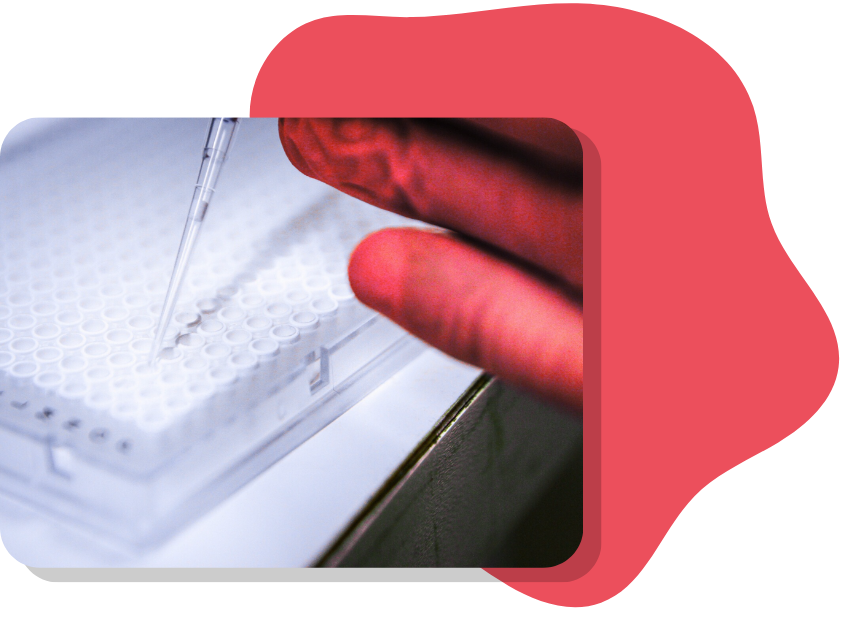-
Assays & Services
MULTISCREENTM Products
Services
Innovations
Have any Questions or Want a Quote?
Talk to a SpecialistSign Up For Our Newsletter
Email Sign Up -
Support
-
Assays & Services
MULTISCREENTM Products
Services
Innovations
Have any Questions or Want a Quote?
Talk to a SpecialistSign Up For Our Newsletter
Email Sign Up -
Support
Cell Based Assays Tailored for Target-Specific Drug Discovery

Cell based assays are essential tools for evaluating the biological activity, efficacy, and safety of compounds in live cells. Compared to traditional biochemical assays, cell based assays provide a physiologically relevant context conducive to more robust analysis of off-target toxicity, receptor function, and intracellular signaling.
Multispan specializes in the custom development of cell based assays tailored to your biological target, from GPCRs and kinases, to ion channels and nuclear hormone receptors. With nearly two decades of experience, our team ensures your assays are optimized for in vivo relevance, reproducibility, and consistent assay performance.
Cell Based Assays Tailored for Target-Specific Drug Discovery

Cell based assays are essential tools for evaluating the biological activity, efficacy, and safety of compounds in live cells. Compared to traditional biochemical assays, cell based assays provide a physiologically relevant context conducive to more robust analysis of off-target toxicity, receptor function, and intracellular signaling.
Multispan specializes in the custom development of cell based assays tailored to your biological target, from GPCRs and kinases, to ion channels and nuclear hormone receptors. With nearly two decades of experience, our team ensures your assays are optimized for in vivo relevance, reproducibility, and consistent assay performance.
What Are Cell Based Assays Used For?

In biology, an assay is a method or procedure employed to analyze and measure the presence, concentration, activity, or function of a biological molecule or substance. Assays serve as fundamental tools in biological research and diagnostics, offering a means to quantify and study various biological components, including proteins, enzymes, nucleic acids, or small molecules. These assays play a crucial role in drug development, specifically screening for the effects of drugs or compounds.
Depending on the nature of the biological target and the desired outcome, scientists may use:
- Biochemical assays to test isolated proteins or enzymes
- Immunoassays for antibody-based detection
- Molecular assays to assess gene expression, DNA/RNA sequences, or genetic variation
Read More
Unlike other assay types, they preserve the complex environment of the cell, allowing researchers to:
- Investigate receptor activation, internalization, or desensitization
- Measure signaling cascades (e.g., calcium, cAMP, β-arrestin)
- Evaluate cell proliferation, apoptosis, or cytotoxicity
- Examine off-target effects or compound toxicity in a live system
These assays are critical in early stages of drug development when compound effects must be evaluated in the context of a live cell.
What Are Cell Based Assays Used For?

In biology, an assay is a method or procedure employed to analyze and measure the presence, concentration, activity, or function of a biological molecule or substance. Assays serve as fundamental tools in biological research and diagnostics, offering a means to quantify and study various biological components, including proteins, enzymes, nucleic acids, or small molecules. These assays play a crucial role in drug development, specifically screening for the effects of drugs or compounds.
Read More
Depending on the nature of the biological target and the desired outcome, scientists may use:
- Biochemical assays to test isolated proteins or enzymes
- Immunoassays for antibody-based detection
- Molecular assays to assess gene expression, DNA/RNA sequences, or genetic variation
So, what are cell-based assays used for specifically?
Unlike other assay types, they preserve the complex environment of the cell, allowing researchers to:
- Investigate receptor activation, internalization, or desensitization
- Measure signaling cascades (e.g., calcium, cAMP, β-arrestin)
- Evaluate cell proliferation, apoptosis, or cytotoxicity
- Examine off-target effects or compound toxicity in a live system
These assays are critical in early stages of drug development when compound effects must be evaluated in the context of a live cell.
Cell Based Assay Development Is One of Multispan’s Most Highly Valued Offerings
Each project begins with a series of critical scientific decisions that shape the final assay design:
Step 1
Unlock Target Biology: Choosing the Right Cell Line
Our MULTISCREENTM assay development process begins with identifying the cell line that best reflects the target’s biology and intended mechanism of action.
We routinely develop assays using two core approaches:
- Primary cells, which express the endogenous form of the target in a native cellular context
- Recombinant stable cell lines, engineered to express heterologous targets or suppress endogenous targets
Read More
We’ve also developed HTS-compatible assays using diverse cell models, including hepatocytes, hiPSC-derived microglial cells, human ventricular interstitial cardiomyocytes (hVIC), primary fibroblasts, PBMCs, and mouse islet cells.
When recombinant systems are preferred, we utilize Multispan’s own panel of highly characterized MULTISCREENTM stable cell lines, which are carefully designed, validated, and QC’d for high throughput screening assays.
What cell line to use?
Step 2
Choose the Right Assay Readout: Measuring What Matters
Once the cell model is selected, the next critical step in cell-based assay development is identifying the most appropriate readout method. The choice of readout determines how accurately and reliably a compound’s activity or mechanism of action is measured.
Read More
Multispan has extensive experience with a wide range of assay formats, allowing us to tailor the readout to your specific research goals. Common techniques include:
- ELISA and Cell-Based ELISA
- Reporter Assays
- Binding Assays
- Second Messenger Assays
- Flow Cytometry (FACS)
- TR-FRET and Fluorescence Assays
- Absorbance or Luminescence Assays
- Radioisotope-Based Assays
What readout to use?
Step 3
Choose the Biology to Measure: Aligning Assay Design with Target Function
With the right cell model and readout selected, the next step in cell-based assay development is defining the specific biological event to measure. This decision depends on the target class, mechanism of action, and how the compound is expected to influence cellular behavior.
Read More
At Multispan, we’ve successfully applied diverse technologies to develop assays across multiple target families, including:
- Serine/threonine kinases
- Receptor tyrosine kinases
- Nuclear hormone receptors
- Ion channels
- Transporters
- And especially G protein-coupled receptors (GPCRs)
For GPCR targets in particular, we offer a wide range of validated assay formats, including:
- Calcium flux assays
- cAMP accumulation
- β-arrestin recruitment
- pERK, pNFκB, IP-1, and pGRK2 phosphorylation assays
- Radioligand binding and GTPγS assays
- Chemotaxis and cytokine secretion
- Luciferase reporter gene activation
- Insulin secretion, cell proliferation, and receptor internalization assays
Our proprietary MULTISCREENTM β-Arrestin Sensor enables functional assays for orphan GPCRs (oGPCRs) in their native form and allows detection of signaling bias using untagged GPCRs in heterologous or primary cells—making true high-throughput oGPCR functional profiling possible for the first time.
We also support cross-species assay development, with pharmacological comparability across orthologs from mouse, rat, ferret, rabbit, dog, pig, and non-human primates. In addition to live-cell assays, we incorporate radioligand binding assays and GTPγS assays are often performed using primary tissue homogenates such as human or rat, mouse, and rabbit brain tissues from wild-type or transgenic animals.
What event or pathway to measure?
Step 4
Choose the Mode of Action: Tailoring Assays for High-Throughput Success
At Multispan, our approach to developing cellular assays is intricately tied to the biology of each target and the specific mechanism of therapeutic intervention. A one-size-fits-all approach doesn’t work in modern drug discovery—each assay must be strategically aligned with how the compound is expected to behave.
Read More
We incorporate the different modalities in our MULTISCREENTM development process as High-Throughput Screening (HTS) is intended, ensuring that assays are meticulously tailored to meet the screening requirements.
Through our MULTISCREENTM development process, we incorporate assay modalities that support diverse mechanisms, including:
- Agonists
- Partial agonists
- Antagonists
- Inverse agonists
- Positive allosteric modulators (PAMs)
- Negative allosteric modulators (NAMs)
What mode of action to target?
What cell line to use?
What readout to use?
What event or pathway to measure?
What mode of action to target?

Step 1
Unlock Target Biology: Choosing the Right Cell Line
Our MULTISCREENTM assay development process begins with identifying the cell line that best reflects the target’s biology and intended mechanism of action.
We routinely develop assays using two core approaches:
- Primary cells, which express the endogenous form of the target in a native cellular context
- Recombinant stable cell lines, engineered to express heterologous targets or suppress endogenous targets
Our MULTISCREENTM assay development process begins with identifying the cell line that best reflects the target’s biology and intended mechanism of action.
We routinely develop assays using two core approaches:
- Primary cells, which express the endogenous form of the target in a native cellular context
- Recombinant stable cell lines, engineered to express heterologous targets or suppress endogenous targets
Read More
We’ve also developed HTS-compatible assays using diverse cell models, including hepatocytes, hiPSC-derived microglial cells, human ventricular interstitial cardiomyocytes (hVIC), primary fibroblasts, PBMCs, and mouse islet cells.
When recombinant systems are preferred, we utilize Multispan’s own panel of highly characterized MULTISCREENTM stable cell lines, which are carefully designed, validated, and QC’d for high throughput screening assays.
Step 2
Choose the Right Assay Readout: Measuring What Matters
Once the cell model is selected, the next critical step in cell-based assay development is identifying the most appropriate readout method. The choice of readout determines how accurately and reliably a compound’s activity or mechanism of action is measured.
Multispan has extensive experience with a wide range of assay formats, allowing us to tailor the readout to your specific research goals. Common techniques include:
- ELISA and Cell-Based ELISA
- Reporter Assays
- Binding Assays
- Second Messenger Assays
- Flow Cytometry (FACS)
- TR-FRET and Fluorescence Assays
- Absorbance or Luminescence Assays
- Radioisotope-Based Assays
Once the cell model is selected, the next critical step in cell-based assay development is identifying the most appropriate readout method. The choice of readout determines how accurately and reliably a compound’s activity or mechanism of action is measured.
Read More
Multispan has extensive experience with a wide range of assay formats, allowing us to tailor the readout to your specific research goals. Common techniques include:
- ELISA and Cell-Based ELISA
- Reporter Assays
- Binding Assays
- Second Messenger Assays
- Flow Cytometry (FACS)
- TR-FRET and Fluorescence Assays
- Absorbance or Luminescence Assays
- Radioisotope-Based Assays
Step 3
Choose the Biology to Measure: Aligning Assay Design with Target Function
With the right cell model and readout selected, the next step in cell-based assay development is defining the specific biological event to measure. This decision depends on the target class, mechanism of action, and how the compound is expected to influence cellular behavior.
At Multispan, we’ve successfully applied diverse technologies to develop assays across multiple target families, including:
- Serine/threonine kinases
- Receptor tyrosine kinases
- Nuclear hormone receptors
- Ion channels
- Transporters
- And especially G protein-coupled receptors (GPCRs)
Read More
For GPCR targets in particular, we offer a wide range of validated assay formats, including:
- Calcium flux assays
- cAMP accumulation
- β-arrestin recruitment
- pERK, pNFκB, IP-1, and pGRK2 phosphorylation assays
- Radioligand binding and GTPγS assays
- Chemotaxis and cytokine secretion
- Luciferase reporter gene activation
- Insulin secretion, cell proliferation, and receptor internalization assays
With the right cell model and readout selected, the next step in cell-based assay development is defining the specific biological event to measure. This decision depends on the target class, mechanism of action, and how the compound is expected to influence cellular behavior.
Read More
At Multispan, we’ve successfully applied diverse technologies to develop assays across multiple target families, including:
- Serine/threonine kinases
- Receptor tyrosine kinases
- Nuclear hormone receptors
- Ion channels
- Transporters
- And especially G protein-coupled receptors (GPCRs)
- Calcium flux assays
- cAMP accumulation
- β-arrestin recruitment
- pERK, pNFκB, IP-1, and pGRK2 phosphorylation assays
- Radioligand binding and GTPγS assays
- Chemotaxis and cytokine secretion
- Luciferase reporter gene activation
- Insulin secretion, cell proliferation, and receptor internalization assays
Step 4
Choose the Mode of Action: Tailoring Assays for High-Throughput Success
At Multispan, our approach to developing cellular assays is intricately tied to the biology of each target and the specific mechanism of therapeutic intervention. A one-size-fits-all approach doesn’t work in modern drug discovery—each assay must be strategically aligned with how the compound is expected to behave.
We incorporate the different modalities in our MULTISCREENTM development process as High-Throughput Screening (HTS) is intended, ensuring that assays are meticulously tailored to meet the screening requirements.
Through our MULTISCREENTM development process, we incorporate assay modalities that support diverse mechanisms, including:
- Agonists
- Partial agonists
- Antagonists
- Inverse agonists
- Positive allosteric modulators (PAMs)
- Negative allosteric modulators (NAMs)
At Multispan, our approach to developing cellular assays is intricately tied to the biology of each target and the specific mechanism of therapeutic intervention. A one-size-fits-all approach doesn’t work in modern drug discovery—each assay must be strategically aligned with how the compound is expected to behave.
Read More
We incorporate the different modalities in our MULTISCREENTM development process as High-Throughput Screening (HTS) is intended, ensuring that assays are meticulously tailored to meet the screening requirements.
Through our MULTISCREENTM development process, we incorporate assay modalities that support diverse mechanisms, including:
- Agonists
- Partial agonists
- Antagonists
- Inverse agonists
- Positive allosteric modulators (PAMs)
- Negative allosteric modulators (NAMs)
Assay Optimization & Format: From Signal to Screening
Once the core components of a cell-based assay are selected—cell model, readout, biology, and mode of action—we move into extensive optimization to ensure the assay is high-performing, reproducible, and ready for high-throughput execution.
We refine each assay to achieve:
- High signal-to-background ratios
- Pharmacologically relevant potency and efficacy measured by tool compounds
FAQs
Assay development is the process of creating reliable and optimized tests for measuring biological activity, known as assays, bioassays or potency assays. Screening utilizes these assays for compound testing to identify lead candidates that exhibit therapeutic or beneficial traits. Both of these processes serve as vital parts of drug discovery research.
Assay development starts with determining the targeted biology to measure, type of assay, detection method, and experimental procedures. Further optimization of the assay is then performed before the final validation of the assay for reliability and functionality. Once validated, the assay is ready to be deployed for use in clinical or research settings.
The time needed to develop a successful assay varies depending on the complexity and goals of the desired assay. Extensive testing and optimization are required in this development process. It may require anywhere from a few months or years to achieve the desired results.
There are three main categories of assays in drug discovery research: biochemical assays, cell-based assays, and immunoassays. Biochemical assays are primarily used in target validation for drug discovery. Cell-based assays are vital in determining cellular activity in response to substances. Immunoassays are used in disease detection and medical diagnostics.
The most common cell-based assays can be categorized into signaling, viability, proliferation, cell death, and cytotoxicity assays. Signaling assays are designed to detect cell response to external stimuli, while viability assays assess the durability and health of cells under various conditions. Proliferation assays measure the growth rate of cells, cell death assays measure the mechanism and rate of cell death, and cytotoxicity assays measure the effect of substances on cells.
